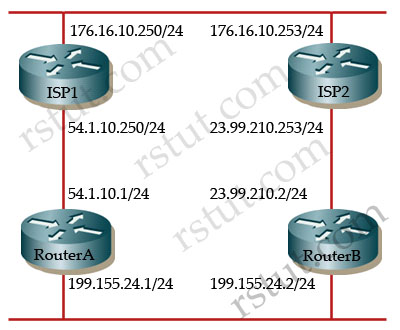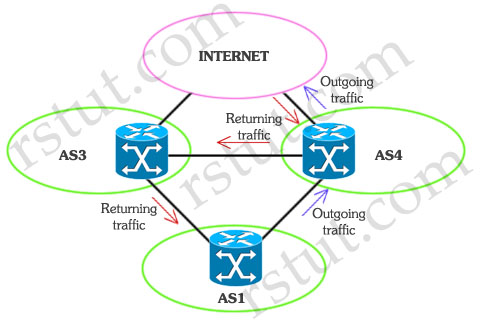Here you will find answers to BGP Questions
Question 1
Two routers configured to run BGP have been connected to a firewall, one on the inside interface and one on the outside interface. BGP has been configured so the two routers should peer, including the correct BGP session endpoint addresses and the correct BGP session hop-count limit (EBGP multihop). What is a good first test to see if BGP will work across the firewall?
A. Attempt to TELNET from the router connected to the inside of the firewall to the router connected to the outside of the firewall. If telnet works, BGP will work, since telnet and BGP both use TCP to transport data.
B. Ping from the router connected to the inside interface of the firewall to the router connected to the outside interface of the firewall. If you can ping between them, BGP should work, since BGP uses IP to transport packets.
C. There is no way to make BGP work across a firewall without special configuration, so there is no simple test that will show you if BGP will work or not, other than trying to start the peering session.
D. There is no way to make BGP work across a firewall.
B. Ping from the router connected to the inside interface of the firewall to the router connected to the outside interface of the firewall. If you can ping between them, BGP should work, since BGP uses IP to transport packets.
C. There is no way to make BGP work across a firewall without special configuration, so there is no simple test that will show you if BGP will work or not, other than trying to start the peering session.
D. There is no way to make BGP work across a firewall.
Answer: A
Question 2
Which types of prefixes will a router running BGP most likely advertise to an IBGP peer, assuming it is not configured as a route reflector?
A. prefixes received from any other BGP peer and prefixes locally originated via network statements or redistributed
B. all prefixes in its routing table
C. prefixes received from EBGP peers and prefixes locally originated via network statements or redistributed
D. prefixes received from EBGP peers and prefixes received from route reflectors
E. prefixes received from other IBGP peers, prefixes received from EBGP peers, and prefixes redistributed to BGP
F. prefixes received from other IBGP peers and prefixes received from route reflectors
B. all prefixes in its routing table
C. prefixes received from EBGP peers and prefixes locally originated via network statements or redistributed
D. prefixes received from EBGP peers and prefixes received from route reflectors
E. prefixes received from other IBGP peers, prefixes received from EBGP peers, and prefixes redistributed to BGP
F. prefixes received from other IBGP peers and prefixes received from route reflectors
Answer: C
Question 3
You have two EBGP peers connected via two parallel serial lines. What should you do to be able to load-balance between two EBGP speakers over the parallel serial lines in both directions?
A. nothing, BGP automatically load-balances the traffic between different autonomous systems on all available links
B. peer between the eBGP speaker’s loopbacks, configuring eBGP multihop as required, and use an IGP to load-share between the two equal-cost paths between the loopback addresses
C. configure a loopback as update source for both EBGP peers and have on each AS an IGP to introduce two equal-cost paths to reach the EBGP peer loopback address; it is also necessary to use the next- hop-self command
D. use the ebgp-load-balance command on the neighbor statement on both sides
E. configure a loopback as update source for both EBGP peers and have on each AS an IGP to introduce two equal-cost paths to reach the peer loopback address; it is also necessary to use the ebgp-multihop and next-hop-self commands
B. peer between the eBGP speaker’s loopbacks, configuring eBGP multihop as required, and use an IGP to load-share between the two equal-cost paths between the loopback addresses
C. configure a loopback as update source for both EBGP peers and have on each AS an IGP to introduce two equal-cost paths to reach the EBGP peer loopback address; it is also necessary to use the next- hop-self command
D. use the ebgp-load-balance command on the neighbor statement on both sides
E. configure a loopback as update source for both EBGP peers and have on each AS an IGP to introduce two equal-cost paths to reach the peer loopback address; it is also necessary to use the ebgp-multihop and next-hop-self commands
Answer: B
Question 4
Which of these best identifies the types of prefixes a router running BGP will advertise to an EBGP peer?
A. prefixes received from any other BGP peer and prefixes locally originated via network statements or redistributed to BGP
B. all prefixes in its IP routing table
C. only prefixes received from EBGP peers and prefixes locally originated via network statements or redistributed
D. only prefixes received from EBGP peers and prefixes received from route reflectors
E. all prefixes in its routing table except the prefixes received from other EBGP peers
E. all prefixes in its routing table except the prefixes received from other IBGP peers
B. all prefixes in its IP routing table
C. only prefixes received from EBGP peers and prefixes locally originated via network statements or redistributed
D. only prefixes received from EBGP peers and prefixes received from route reflectors
E. all prefixes in its routing table except the prefixes received from other EBGP peers
E. all prefixes in its routing table except the prefixes received from other IBGP peers
Answer: A
Question 5
Refer to the exhibit. Users on the 199.155.24.0 network are unable to reach the 172.16.10.0 network. What is the most likely solution?
 |
Router A relevant configuration
router bgp 200 neighbor 54.1.10.250 remote-as 100 network 54.1.10.0 mask 255.255.255.0 network 199.155.24.0 mask 255.255.255.0
Router B relevant configuration
router bgp 200 neighbor 23.99.210.253 remote-as 300 network 23.99.210.0 mask 255.255.255.0 network 199.155.24.0 mask 255.255.255.0
Router ISP1 relevant configuration
router bgp 100 neighbor 54.1.10.1 remote-as 200 network 54.1.10.0 mask 255.255.255.0
Router ISP2 relevant configuration
router bgp 300 neighbor 23.99.210.2 remote-as 200 network 23.99.210.0 mask 255.255.255.0 |
A. Router ISP1 should be configured to peer with router B.
B. Router ISP2 should be configured with no synchronization.
C. Router ISP1 should be configured with no synchronization.
D. Router ISP2 should be configured with no auto-summary.
E. Router ISP1 or IPS2 should be configured with network 176.16.10.0 mask 255.255.255.0.
B. Router ISP2 should be configured with no synchronization.
C. Router ISP1 should be configured with no synchronization.
D. Router ISP2 should be configured with no auto-summary.
E. Router ISP1 or IPS2 should be configured with network 176.16.10.0 mask 255.255.255.0.
Answer: E
Question 6
Two BGP peers connected through a routed firewall are unable to establish a peering relationship. What could be the most likely cause?
A. BGP peers must be Layer 2-adjacent.
B. EBGP multihop is not configured.
C. The firewall is not configured to allow IP protocol 89.
D. The firewall is not configured to allow UDP 179.
B. EBGP multihop is not configured.
C. The firewall is not configured to allow IP protocol 89.
D. The firewall is not configured to allow UDP 179.
Answer: B
Question 7
Refer to the exhibit. BGP-4 routing to the Internet, in normal behavior, may create asymmetrical routing for different prefixes. The BGP routing table indicates that traffic should follow the paths indicated in the exhibit, but packets are not going further than the border router in AS 4. What could be the cause of this problem?

A. TCP Intercept is configured in AS 4.
B. Unicast Reverse Path Forwarding is configured in loose mode in this router.
C. Packets may be leaving AS 1 without the BGP routing flag set to 1.
D. Unicast Reverse Path Forwarding is configured in strict mode in this router.
E. There is a missing Unicast Reverse Path Forwarding configuration.
B. Unicast Reverse Path Forwarding is configured in loose mode in this router.
C. Packets may be leaving AS 1 without the BGP routing flag set to 1.
D. Unicast Reverse Path Forwarding is configured in strict mode in this router.
E. There is a missing Unicast Reverse Path Forwarding configuration.
Answer: D
Sign up here with your email

ConversionConversion EmoticonEmoticon